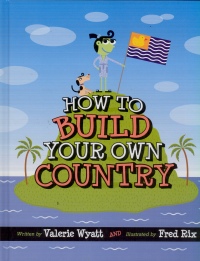| ________________
CM . . .
. Volume XVII Number 23. . . .February 18, 2011 
 |
How to Build Your Own Country.
Valerie Wyatt. Illustrated by Fred Rix.
Toronto, ON: Kids Can Press, 2009.
40 pp., hardcover, $18.95.
ISBN 978-1-55453-310-7.
Subject Headings:
Civics-Juvenile literature.
Citizenship-Juvenile literature.
Grades 4-6 / Ages 9-11.
Review by Gail Hamilton.
**½ /4
|
| |
|

excerpt:
Everyone likes to make money, but in your case, you'll be doing it literally. You'll need currency (coins and bills) that people can use for transactions in your country. Many countries put their kings and queens or other famous people on their money. But since this is your country, feel free to use your own likeness. And your currency should have a name. Warning: "dollar" has been taken by more than twenty countries, and "dinar" is also popular. If you want to stick with d-words, what about the "doo-dad" or the "dimple"?
Once you've named and manufactured currency, it's time to establish its value, and that will depend on how well your economy does. If your economy slumps, so will your dimple. If your economy booms, your dimple will, too.
The goal of the "CitizenKid" book collection is to teach children about the world and to inspire them to become better global citizens. Most of the titles in the collection are serious in nature, but this one injects some humour into the topic and takes a tongue-in-cheek look at a fictional republic in order to explain to readers how a country works. The imaginary Republic of Bathmatia, the size of a bathmat, population three, is a democracy whose capital city is Lintbourg. Its flag bears wavy blue and white stripes with a rubber ducky in the upper lefthand corner, and its national holiday is Come Clean Day. Bathmatia is located near the countries of Sinkestan (capital city: Dripsalot)), Bathtubia (capital city: Starkers) and Toiletland (capital city: Flushing). But while readers are laughing at the subtle- and not so subtle- jokes, they will also be learning about the various components of starting one's own country.
Basically, there are three important steps, the first of which is to stake out one's identity. This involves naming the country, creating a passport, finding a population, designing a flag, writing a national anthem and choosing a motto. Throughout this chapter, there are suggestions and real-life examples of each. For instance, one can name a country after a person (Bolivia is named for Simon Bolivar), a colour (Greenland), a description (Iceland) or a direction (East Timor). Adding "stan", meaning "land", to one's name is another option.
The second step is running the country, not an easy task. Topics in this section include the formation of a government and a justice system, the establishment of an economy, and the creation of roads, schools and hospitals, all for the greater good of the country's citizens. Here, readers will learn about various types of governments in the world, what should be included when writing a constitution, laws, taxes, trade, currency, services, and creating national holidays.
Finally, the third step involves relationships between one's country and other nations in the world. There are facts about the world's largest and smallest countries, the oldest and youngest, and the richest and poorest, as well as some of the changes made to existing countries such as borders, names, and even their disappearance altogether. A country's Gross Domestic Product (GDP), the importance of peacekeeping, and the formation of "clubs" with other nations (e.g. NATO, UN) in pursuit of a common goal are discussed. Also listed are examples of children as young as five who have started their own countries, even if some of the "countries" existed only among friends or online. At the back of the book, there is a Bathmatia Fact File, mimicking the fact files found in geography books. A table of contents, a glossary and an index are also provided.
Even though the book is humourous, there is a lot of important information imparted. The text is written in kid-friendly language in a conversational style, and concepts are explained in a manner that is easy for kids to grasp. And though some of the suggestions are outlandish (such as changing the words to a catchy tune like "Do Your Ears Hang Low" and adopting it as a national anthem), most are quite serious, some examples being the creation of a motto that effectively tells others what the country stands for, or the writing of a constitution in order to set out the principles of a country and the rights of its citizens. Illustrations consist of colourful, flat cartoon-like drawings that add even more humour to the text and suit the quirky style of the book.
How to Build Your Own Country would be a great starting point for a fun and educational class project that could be done in small groups or by individual students. A most enjoyable read!
Recommended.
Gail Hamilton is a former teacher-librarian in Winnipeg, MB.

To comment
on this title or this review, send mail to cm@umanitoba.ca.
Copyright © the Manitoba Library Association. Reproduction for personal
use is permitted only if this copyright notice is maintained. Any
other reproduction is prohibited without permission.
NEXT REVIEW |
TABLE OF CONTENTS FOR THIS ISSUE
- February 18, 2011.
AUTHORS |
TITLES |
MEDIA REVIEWS |
PROFILES |
BACK ISSUES |
SEARCH |
CMARCHIVE |
HOME |
